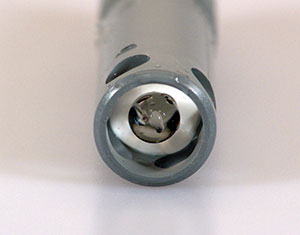pH Measurement Methods - Advantages and Disadvantages
Determining the value of pH could be done via potentiometric or optical methods. The potentiometric methods relate to the measurement of electrical voltages on pH-sensitive electrodes. Optical methods involve the visual and photometric analysis of pH-dependent color changes.
Optical pH Measurement
These methods use pH-dependent color changes of specific organic pigments, so-called color indicators. For example as the pH value increases, the color of methyl red in an aqueous solution changes from red to yellow at a pH of 4.9. Phenolphthalein for example turns reddish at a pH of 9.5. The best known of these is the pH indicator paper or pH test strips, which are prepared with indicator solutions of these organic pigments. The pH value is estimated by means of a visual comparison of the color against a color scale. However, the precision is only sufficient to provide a rough estimate.
Photometric pH Measurement
The color change of the indicator pigments can also be photometrically determined by shining a light and  measuring the absorbance. These methods are referred to either as colorimetric or spectrophotometric, depending on the equipment and light source used. In theory, it is possible to take pH measurements in this way. However, the method is very prone to interference and the equipment needed is large.
measuring the absorbance. These methods are referred to either as colorimetric or spectrophotometric, depending on the equipment and light source used. In theory, it is possible to take pH measurements in this way. However, the method is very prone to interference and the equipment needed is large.
Disadvantages of the Optical Methods
The area of application for optical pH measurement, be it visual or photometric, is very limited. If the solution to be measured is cloudy or has an inherent color, the measurements will be unreliable. Some measurement solutions also contain chemical bonds which destroy the color indicators through oxidation or reduction and produce incorrect results.
Potentiometric Determination of the pH Value
This method uses the electrical potential of pH-sensitive electrodes as a measurement signal. A distinction is made between hydrogen, metal, and glass electrodes. The glass electrode is the most commonly used sensor today. Not having the disadvantages of the optical methods, it can be used almost universally. It is one of the most sensitive and at the same time most selective sensors there is and has an unmatched measurement of pH 0 to 14, which means from percent to ppq (= parts per quadrillion = one molecule in one quadrillion other molecules).

pH Measurement with the Antimony Electrode
On some metals, there are redox processes that depend directly on the hydrogen ion activity of the solution. For example, the oxidation or reduction of antimony (Sb), which depends on hydrogen ion activity, can be used as a measurement of pH.
m · Me + n · H2O ⇔ MemOn+ 2nH+ + 2n · e-
2 Sb + 3 H2O ⇔ Sb2O3 + 6H+ +6e-
Functional Principle of the Hydrogen Electrode
If a fine platinum mesh bathed with hydrogen gas is immersed in an aqueous solution, this arrangement represents an electrode of the first kind, the so-called "hydrogen electrode". Some of the hydrogen molecules donate electrons to the platinum and are released as hydrogen ions in solution:
Pt
H2 + 2H2O ⇔ 2H3O+ + 2e-
The hydrogen electrode is an electrode of the first kind, whose potential at constant hydrogen pressure (1 bar) depends solely on the activity of the hydrogen ions in the solution. The hydrogen potential is measured on the platinum, a first-order conductor. For the actual redox process of the hydrogen electrode, the platinum is chemically inert. It functions solely as an intermediate: depending on the direction of the current, hydrogen can be deposited as metal or converted to ions.
U = UN · lg aH+ = UN · pH
Applications of the Hydrogen Electrode
Theoretically, pH value can be identified very precisely with the hydrogen electrode. In practice, however, working with the hydrogen electrode is expensive and cumbersome. High-purity hydrogen and constant hydrogen pressure are conditions that are hard to create in a practical setting. The hydrogen electrode will also fail if the solution contains heavy metal ions which contaminate the platinum surface. Reductive or oxidizing components in the measuring solution also lead to undesired side reactions and therefore to errors in measurement.
The hydrogen electrode is consequently only used today under very specific defined conditions for more scientific purposes. The same applies to the so-called quinhydrone electrode. As a special form of hydrogen electrode, today it is seldom used. (Learn more, Anatomy of pH Electrodes).
Summary
According to the theory of Brønstedt, acids are substances that are capable of separating hydrogen ions. Bases on the other hand enable the deposition of hydrogen ions.
A distinction is made between weak and strong acids and bases. Strong acids and bases are generally almost completely dissociated, weak ones on the other hand are only incompletely dissociated. In addition, a distinction is made between the molar concentration (previously: molarity) and the equivalent concentration (previously: normality). The molar concentration means moles per liter and the number of dissociable hydrogen ions is still included in the definition of equivalent concentration, i.e. mol/liter divided by the number of dissociable hydrogen ions.
The electrode potential can be determined on the basis of the Nernst equation. The measurement voltage is the difference between two electrode potentials. Whether a reaction can proceed depends on the thermodynamic requirements. The decisive factor is the change in free enthalpy ΔG. (Learn more, How to Choose a pH Electrode).

Additional pH Blog Posts of Interest:
The Ultimate pH Primer - Are You Familiar with Hydrogen?
pH Meter Calibration Problems? Check Out These 12 Tips!
Extend the Life of Your pH Electrode in 3 Practical Steps
Why is the pH Scale Logarithmic?